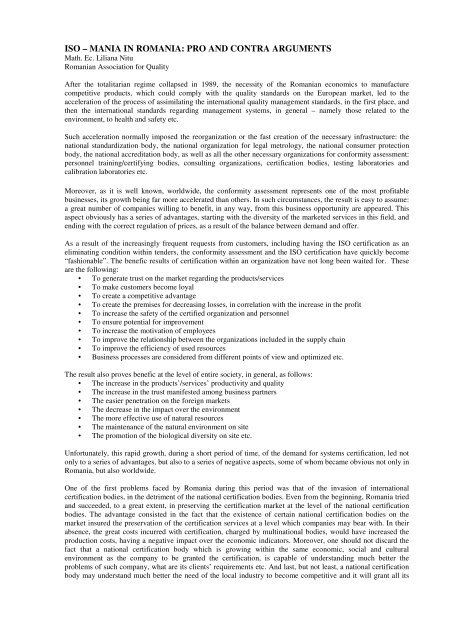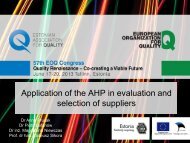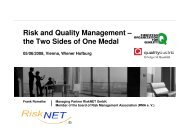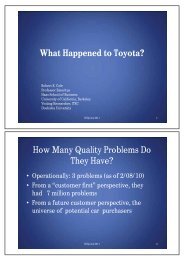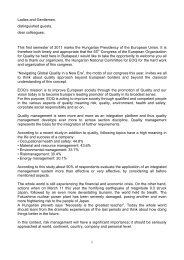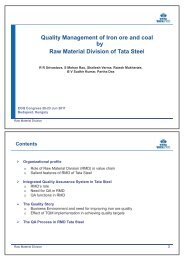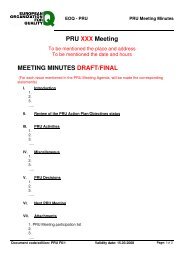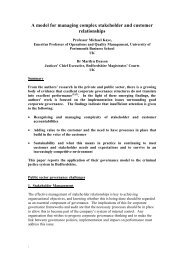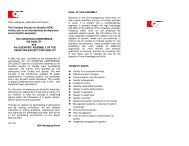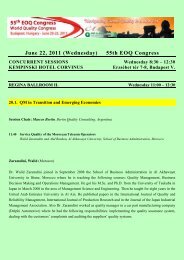iso – mania in romania: pro and contra arguments - European ...
iso – mania in romania: pro and contra arguments - European ...
iso – mania in romania: pro and contra arguments - European ...
You also want an ePaper? Increase the reach of your titles
YUMPU automatically turns print PDFs into web optimized ePapers that Google loves.
estrictive. On a market where such th<strong>in</strong>gs occur frequently, the <strong>pro</strong>blem of the certification body reduces to amere issue: it leaves the market, if it preserves its strict assessment conditions, or it rema<strong>in</strong>s on the market, bygiv<strong>in</strong>g it up. This may lead <strong>and</strong> it has even led to some extent, to a wrong perception that organizations have,accord<strong>in</strong>g to which the respective certificate is noth<strong>in</strong>g but a piece of paper which may be bought as any other<strong>pro</strong>duct, without the applicant organization’s putt<strong>in</strong>g a high effort <strong>in</strong>to deserv<strong>in</strong>g it. This perspective is extremelyharmful as far as the certification system’s credibility is concerned, <strong>and</strong> what is even more severe, is that suchloss of credibility is not felt only on a national scale, but on a worldwide one.In order to elim<strong>in</strong>ate, as far as possible, the causes for such an ap<strong>pro</strong>ach, <strong>in</strong> Ro<strong>mania</strong>, the Ro<strong>mania</strong>n Associationfor Quality, ARC, as a representative organization <strong>in</strong> this field, tried to act <strong>in</strong> two directions. The first directionwas to <strong>pro</strong>mote a set of criteria <strong>in</strong> order to select a consult<strong>in</strong>g organization/or a certification body <strong>in</strong>clud<strong>in</strong>gethical behaviour of their employees.The basic idea was that of chang<strong>in</strong>g, if possible, the organizational culture regard<strong>in</strong>g quality <strong>in</strong> general <strong>and</strong>certification, especially, by <strong>in</strong>sist<strong>in</strong>g with<strong>in</strong> the organized events, upon the <strong>in</strong>ternal advantages of a managementsystem <strong>and</strong> only after that, on the external advantages. Concern<strong>in</strong>g such advantages, they become true only if theorganization which <strong>pro</strong>vides consultancy, respectively the certification body, is credible, <strong>and</strong> this credibility isgiven by some essential aspects.Regard<strong>in</strong>g the organizations offer<strong>in</strong>g consultancy, these aspects <strong>in</strong>clude the follow<strong>in</strong>g:a. The impartiality of the consult<strong>in</strong>g organization towards the certification body; cases when theconsult<strong>in</strong>g organizations “recommends” certification by a certa<strong>in</strong> certification body, are not at all rare.Such consultants should be avoided, because their lack of impartiality towards the certifier is obvious,so it is expected that the management system designed <strong>and</strong> implemented by the consultant, is not aneffective <strong>and</strong> competitive one, because the certification is ensured <strong>in</strong> the virtue of the “goodrelationship” with the certification body, anyway.b. The quality of the consult<strong>in</strong>g <strong>pro</strong>cess: consult<strong>in</strong>g does not mean “sell<strong>in</strong>g” a documentation, more oftenthan not, be<strong>in</strong>g so general, that a possible reader may not identify even the company’s field of activityfor which is it assumed that it had been elaborated. Moreover, consult<strong>in</strong>g also does not mean theconsultant elaborat<strong>in</strong>g <strong>pro</strong>cedures. An effective system, which suits the organization’s features, may beperformed only to the extent <strong>in</strong> which such documentation is elaborated even by the <strong>pro</strong>cess owners,obviously, guided by the counselor. This is why consult<strong>in</strong>g organizations /consultants, who motivat<strong>in</strong>gthey do not want to “<strong>in</strong>terfere” <strong>in</strong> any way with the respective company’s bus<strong>in</strong>ess, offer a “ready touse” documentation, should be avoided. In the same context, the consultants’ competence is alsoimportant, as well as their tra<strong>in</strong><strong>in</strong>g <strong>and</strong> recommendations.c. The duration estimated for design<strong>in</strong>g/develop<strong>in</strong>g/implement<strong>in</strong>g the system: Those consult<strong>in</strong>gorganizations/consultants, which <strong>pro</strong>pose 2-3 months as a design<strong>in</strong>g / develop<strong>in</strong>g / implement<strong>in</strong>gperiod, should also be avoided. A system which is designed <strong>and</strong> implemented <strong>in</strong> such short a time is byfar an <strong>in</strong>effective one.d. The clarity of the <strong>contra</strong>ctual agreements <strong>and</strong> guarantees: the fact that the consult<strong>in</strong>gorganization/consultant <strong>pro</strong>vides consult<strong>in</strong>g for elaborat<strong>in</strong>g the documentation is <strong>in</strong>sufficient;implement<strong>in</strong>g the system is as important, <strong>and</strong> the consult<strong>in</strong>g organization must support the companydur<strong>in</strong>g this stage, as well. In fact, the consultant’s role is completed when the company obta<strong>in</strong>ed thesystem’s certification.Regard<strong>in</strong>g the certification body, these aspects <strong>in</strong>clude the follow<strong>in</strong>g:a. The impartiality of the certification body towards the other participants to the certification field,towards the consult<strong>in</strong>g organization <strong>and</strong> towards the accreditation body. Nobody is surprised any longerwhen, beh<strong>in</strong>d a certification body, there is a consult<strong>in</strong>g organization. As an organization will<strong>in</strong>g toobta<strong>in</strong> the certification, cases <strong>in</strong> which the certification body recommends the consultant, should beavoided. As long as impartiality is not ensured, the results of the audit performed by the certificationbody will not be objective <strong>and</strong> they will not br<strong>in</strong>g any benefit to the certified company; on the otherh<strong>and</strong>, the credibility of the certification should also be considered, granted by certa<strong>in</strong> certificationbodies, which, are owned, under cover, even by the personnel with<strong>in</strong> the body’s management or by theirbus<strong>in</strong>ess partners, <strong>in</strong> which case a certification body obta<strong>in</strong>s the accreditation with<strong>in</strong> one week, while anhonest certification body waits months to pass until it is granted the same accreditation.b. The draw<strong>in</strong>g up, by the certification bodies, of certa<strong>in</strong> clear <strong>and</strong> well documented <strong>contra</strong>ctualagreements. The agreements issued by the certification bodies many times happened to be extremelyvague, without stipulat<strong>in</strong>g the obligations the apply<strong>in</strong>g organization has towards the certification body<strong>and</strong> the other way round. Such an agreement should also <strong>in</strong>clude the appeal <strong>pro</strong>cedures to which theapply<strong>in</strong>g organization is entitled, <strong>in</strong> case certa<strong>in</strong> disputes regard<strong>in</strong>g the performed audits occur, <strong>and</strong> itshould clearly establish all the related costs: the costs for the certification, for the ma<strong>in</strong>tenance <strong>and</strong> forthe re-certification audits, as well as other additional costs, if case may be. There are certa<strong>in</strong>
certification bodies which charge extra fees for the right to use the issued certificate, <strong>in</strong> the virtue of thecopyright law, without mention<strong>in</strong>g such costs <strong>in</strong> the <strong>contra</strong>ctual agreement.c. The duration of the certification audit <strong>and</strong> the frequency <strong>and</strong> duration of the surveillance audits: theyshould correspond to the size <strong>and</strong> complexity of the organization to be certified. Not few times, out ofthe desire to w<strong>in</strong> money, certification bodies are tempted to reduce the number of audit<strong>in</strong>g days,<strong>contra</strong>ry to the number of days recommended by the applicable guides. This practice does not come tothe advantage of the future certified organization, because surely there will be <strong>pro</strong>cesses or activitieswhich had not been covered dur<strong>in</strong>g the assessment, so the degree of confidence <strong>in</strong> the audit<strong>in</strong>g reportdecreases.d. The competence <strong>and</strong> the ethical behaviour of the auditors used by the certification body for perform<strong>in</strong>gassessments. From this po<strong>in</strong>t of view, Ro<strong>mania</strong>, too, faces the <strong>in</strong>consistency of the requirementsregard<strong>in</strong>g the auditors’ qualification, from one certification body to another. More exactly, most of thetimes, the certification bodies <strong>in</strong>ternally qualify their auditors, more or less <strong>in</strong> compliance with thequalification requirements as per ISO 19011, let alone a series of other knowledge <strong>and</strong> abilitiesabsolutely necessary for develop<strong>in</strong>g an effective audit: the ability to perform an audit which is <strong>pro</strong>cessoriented,the existence of personal skills, the comprehension of certa<strong>in</strong> advanced management concepts,but not only for quality management.In order to support all the persons <strong>in</strong>volved <strong>in</strong> the certification <strong>pro</strong>cess, the Ro<strong>mania</strong>n Association for Quality,ARC, acts on another direction, namely by ensur<strong>in</strong>g highly tra<strong>in</strong>ed <strong>and</strong> certified personnel, accord<strong>in</strong>gly torequirements recognized all over Europe.Thus, ARC has currently created a true audit school, based on the PRU-EQO scheme. This certification schemebecomes more <strong>and</strong> more famous <strong>and</strong> appreciated <strong>in</strong> Ro<strong>mania</strong>, due to the competence, <strong>pro</strong>fessionalism <strong>and</strong> ethicalbehaviour of auditors certified accord<strong>in</strong>g to this scheme. An important element with<strong>in</strong> the tra<strong>in</strong><strong>in</strong>g of futureauditors is represented by the ap<strong>pro</strong>ach of third party audit, from the perspective of the added value for theaudited organization. As worldwide, certification loses ground as far as the external credibility is concerned,certified organizations look for advantages not out of doors, but <strong>in</strong>side of it, <strong>in</strong> the area of the added value of acertification audit. It is a new challenge to which an auditor must be capable to give a <strong>pro</strong>per answer, <strong>and</strong> ARCtries to meet such new requirements. There are <strong>in</strong> Ro<strong>mania</strong> certa<strong>in</strong> certification bodies <strong>–</strong> all national <strong>–</strong> which useauditors tra<strong>in</strong>ed <strong>and</strong> certified <strong>in</strong> compliance with the PRU-EOQ scheme only, which have a good nationalrenown <strong>and</strong> which do everyth<strong>in</strong>g possible to im<strong>pro</strong>ve the certification credibility.Moreover, last year, ARC developed <strong>and</strong> started to run the PRU-EOQ certification scheme for certify<strong>in</strong>gmanagement systems consultants, accord<strong>in</strong>gly with the requirements of st<strong>and</strong>ard ISO 10019 also. Although thepurpose of this st<strong>and</strong>ard is not to be a referential for personnel certification, a series of requirements may beuseful for ensur<strong>in</strong>g the <strong>pro</strong>fessionalism <strong>and</strong> the ethical behaviour of future consultants. Obviously, the purpose ofthis step is that of also constitut<strong>in</strong>g the bases of a nationally acknowledged school for management systemsconsultants.Unfortunately, these steps are not sufficient enough to stop the degradation of the certification’s image,especially because they ensure the “downwards <strong>–</strong> upwards” ap<strong>pro</strong>ach only. Without an upwards<strong>–</strong>downwardsconsistent ap<strong>pro</strong>ach, as well, efforts will <strong>pro</strong>ve useless. In this sense I th<strong>in</strong>k we should consider certa<strong>in</strong> aspects:• To establish worldwide requirements which should be more exigent for accreditation/certificationbodies, <strong>in</strong>clud<strong>in</strong>g as regards the used assessment personnel, <strong>and</strong> possibly, to establish certa<strong>in</strong> unitarycriteria for the assessment personnel certification/registration, which are clearer <strong>and</strong> more exhaustivethan the ones mentioned <strong>in</strong> ISO 19011.• A more thorough control made by EA to accreditation bodies, <strong>in</strong>clud<strong>in</strong>g as regards the analysis ofrelationships with related bodies.• A more effective control system from the accreditation bodies to the certification bodies, possibly byperform<strong>in</strong>g extraord<strong>in</strong>ary surveillance audits.• To create a feed-back collect<strong>in</strong>g system from the end customers of the certification system, namelyfrom consumers, regard<strong>in</strong>g the effective efficiency of systems with<strong>in</strong> the certified organizations <strong>and</strong> toconsider them <strong>in</strong> the case of surveillance audits.ConclusionsIn order to stop the deterioration of the credibility of management systems certification, there must be a mutualwill <strong>and</strong> a close global collaboration, with<strong>in</strong> all the <strong>in</strong>volved structures: the IAF, the regional accreditationgroups, like EA, IAAC, PAC etc, national accreditation bodies, systems certification bodies, consult<strong>in</strong>gorganizations, personnel tra<strong>in</strong><strong>in</strong>g/certification organizations, companies etc. If the end users’ perception aboutthe necessity <strong>and</strong> the advantages of the existence of the systems certification schemes does not im<strong>pro</strong>ve quickly,the deterioration <strong>pro</strong>cess will cont<strong>in</strong>ue, end<strong>in</strong>g by becom<strong>in</strong>g considered them as useless.


